-
Day 14. Middlebury to Hamilton
In which we have a maple syrup breakfast, go for a stroll in a historic town, get ferried across a lake, and see cows and cannon.

After a pleasant night’s rest in our room, we headed down to the very charming dining room for breakfast.
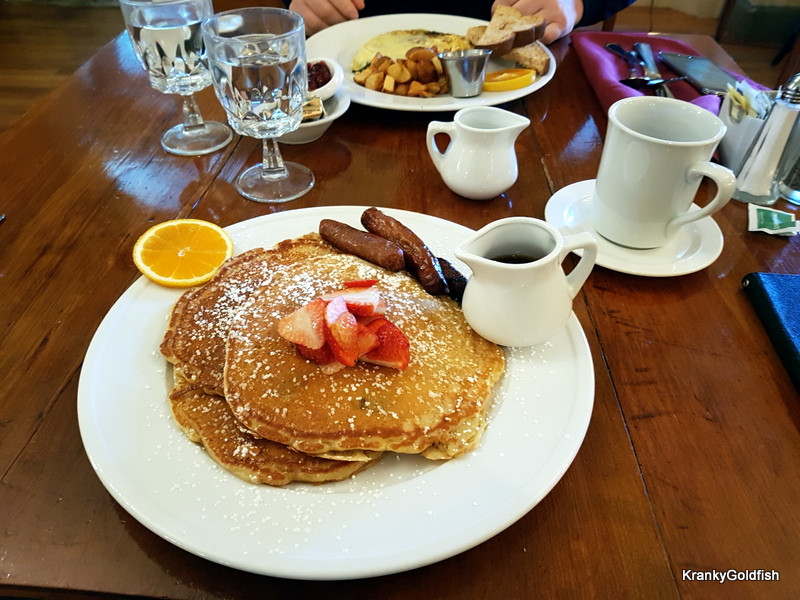
And as Doreen says, when in Vermont, have maple syrup with your breakfast. Pancakes, fruit, and maple syrup I get. They make sense, although are arguably a dessert. But sausages? Sausages and fruit, and syrup? American breakfasts baffle me sometimes. But I guess I don’t have a sweet tooth, so maybe it makes sense to other people.
Also, Doreen says the sausages were a bit dry. She regrets not choosing the bacon.

I had a more savoury breakfast, a hearty three egg omelette with cheese, veggies and herbs, and some cottage fries and toast as well, because why not? It was all very yummy, and I would like to note here that we had quite a small lunch.
We allowed some time to go for a stroll around Middlebury. Nowadays it’s most well known for Middlebury College, but in its history it has been the seat of the Vermont legislature and was in the early 19th century one of the largest towns in Vermont. Which, not to be critical, isn’t all that hard, as the population of the whole state is only about 650,000 now.
But it’s a lovely place, a classic little New England town and well worth a look around.

The Congregational Church is a beautiful building, perched on a rise on Main Street. Of course it’s the kind of town that has a Main Street!

The Episcopalian Church, nestled on the town green just a couple of hundred yards from the Congregationalists, is for a change not a building made out of wood.

Middlebury is the kind of town where businesses fill their window-boxes with bright flowers. And they do it unironically.
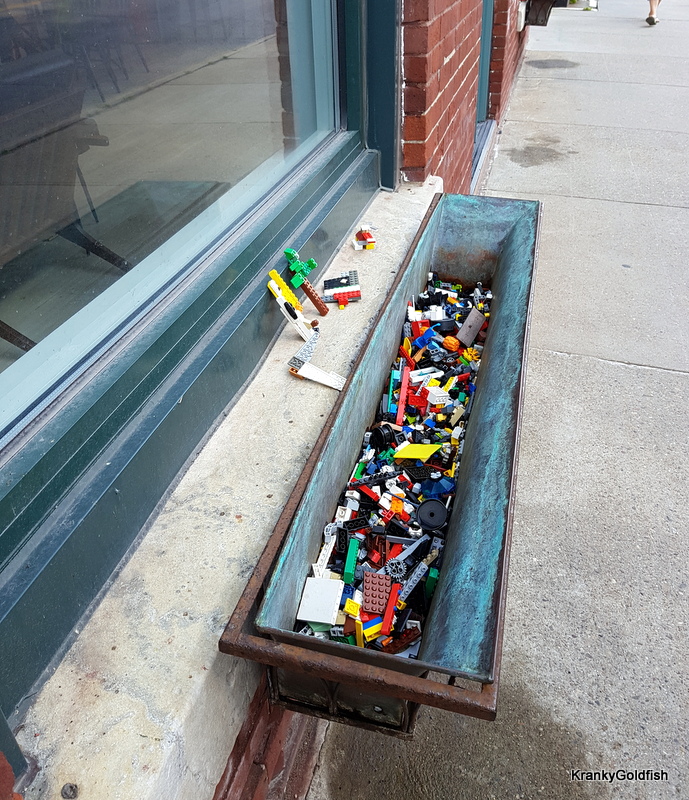
Okay, not all the businesses put flowers in their window-boxes. This one has a big collection of construction bricks so the younglings can have a play while the parents are inside shopping.

Continuing along Main Street, we came to the bridge over Otter Creek, with a view of the falls and Riverside Park. Everything is picturesque!

The town library is a dignified building, of substance and solidity. You can bet that in another hundred years it will still be here. Although by then it may have been adaptively re-used into a steakhouse.
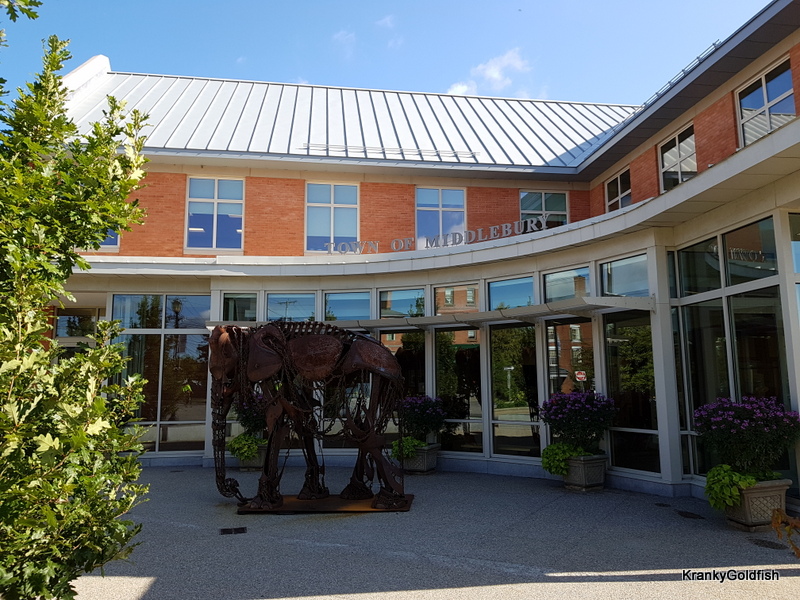
The city offices, on the other hand …. I mean, at some point in the middle of the 20th century, architects just kind of gave up on style and went full bland utilitarian, or, worse, brutalist. You can bet that in a hundred years, this will have been bulldozed and replaced with something else. Maybe then “Gravity” the Asian elephant will no longer be in the shadows.
Hopefully.
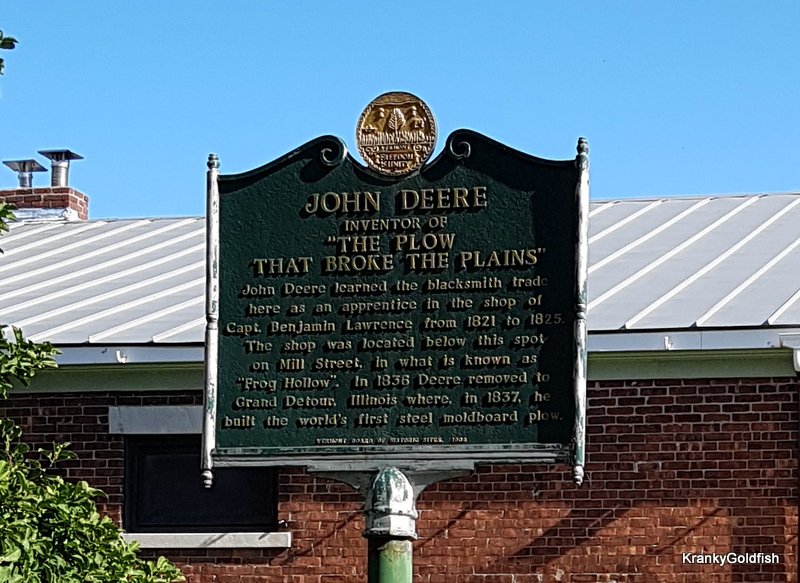
Apart from the college and legislature, the town is famous for something that didn’t happen. John Deere wasn’t born here, and he didn’t invent the self-scouring plow here. But he lived here for a few years and learned blacksmithing here. So, there’s that.

And other historical things happened here. Anyone who thinks that activist judges are a recent phenomenon, think again.

Walking a ways further we came to another bridge over the very charming Otter Creek.

The texture and shapes of the waterplants in the current, contrasting with the pebbles and rocks on the bank, caught my eye, and I leaned over for a close-up.

Yet another stately building, this was the Inn on the Green when we visited but has since closed.
So having had a very pleasant stroll, we checked out of the Middlebury Inn. Into The Mighty Sentra we hopped and motored off towards our next destination, Fort Ticonderoga. We needed to cross Lake Champlain to get there and had to make a choice. There is a bridge north of Crown Point, more or less due west of Middlebury, or a ferry right by Fort Ti.

We chose the ferry, and were really glad that we did.

A ferry has more soul than a bridge. We got to queue for a couple of minutes, and then drive on, park and get out of the car and admire the waters of the lake. A cool breeze blew on our faces, the sun was shining down from the blue sky, and it was a lovely restful moment as the ferry put-putted across the lake. Sure, it cost a few bucks extra, but it was well worth it.
We kept our eyes peeled hoping to catch a glimpse of Champy, the Lake Champlain monster. Sadly, he was not to be seen that day. Some people – people with small imaginations – think that Champy is a myth, or a large river snake, or maybe a stick. But we believe.

There was a basket of fruit for travellers to help themselves from, and the chance to buy a commemorative t-shirt. You don’t get that on a bridge.

Mr Cow enjoyed the trip too. But I do wish he would keep his eyes on the road.

Fort Ticonderoga was first built by the French as Fort Carillon in 1755, early in the Seven Years War (known in America as the French and Indian War). It was built on a bluff above a narrow part of Lake Champlain at the nearest point to Lake George, and it commands the passage of boats on the lake.

The fort closes for the winter each year. Upstate New York gets very, very cold. The location was of great strategic importance, as Lake Champlain is connected by rivers and lakes to the St. Lawrence River just down from Montreal, and Lake George is just a 10 mile portage from the Hudson River which leads directly down to Albany and New York City. At the time, New England and upstate New York were complete wildernesses away from the coasts and rivers. For a British or French army to attack to or from Canada, the lake and river system was the next best thing to a highway.

A view from the bluff just below the fort, looking south along Lake Champlain. You can see how the height and location gives great visibility over the lake.
For a fort whose effective life was less than 30 years, it saw a lot of action. The British attacked it unsuccessfully in a major seige and assault in 1758. Both sides retired for the winter, and the British attacked again in early summer of 1759, this time successfully.
In 1775, at the very start of the Revolutionary War, a force of American militia led by Benedict Arnold and Ethan Allen surprised the British garrison and took the fort. The cannons of the fort were transported, in an epic slog through mud and snow in the winter of 1775-6, to Boston where they were instrumental in raising the British siege. So, the guns of Fort Ti, in a roundabout way, saved the American revolution.

In July 1777, British troops returned and occupied a nearby mountain that overlooked the fort. The American garrison, in an impossible position, withdrew before the British could attack, and the British moved in again. In September that year, the Americans returned and tried one last, unsuccessful attack.
And that was it for Fort Ti.
The fort was abandoned by the military in 1782, was stripped for building materials by locals, and fell into utter disrepair.

In the early 1900s the site was acquired by the wealthy Pell family, who restored the fort and opened it to the public as a historic site.
The thing was, they restored it in a way that it never was. The walls, ditches and building are all in about the right location, sure. But the original walls were wood front and back with soil filling between them. Work started on facing them with stone but it was never completed. The new fort is more solid and much better maintained than the original, and I would guess that the replica buildings are lighter and airier.
It’s an altogether romanticised version of history. And maybe that’s how we prefer it.

Looking through the main gate of the fort into the courtyard.

View from the rampart of the fort looking west. The height to the left of the shot is the start of Mount Definance, where the British placed their cannon in preparation for the 1777 attack. The fort was perfectly placed to cover the lake, but having higher ground nearby was a fatal flaw.

Detail of the moulding on one of the cannon. Most of the cannon are real 18th century pieces, but as they were acquired in the early 1900s they are not the originals from the fort. From the fleurs-de-lys on the coat of arms it does appear to be French.

Interior courtyard of the fort, barracks building on the left, smithy and workshops straight ahead.
The barracks building contains a great collection of military and civilian 18th century artifacts and displays, showing the history of the region and detailing the lifestyle of locals both native and colonial at the time. I spent well over an hour there and wish I had time for more.

A few times through the day, local re-enactors stage demonstrations of activities of the time. The theme changes, but when we were there it was the process of loading and firing the cannons, wearing the uniforms of French artillerists. Here, the audence is summoned.
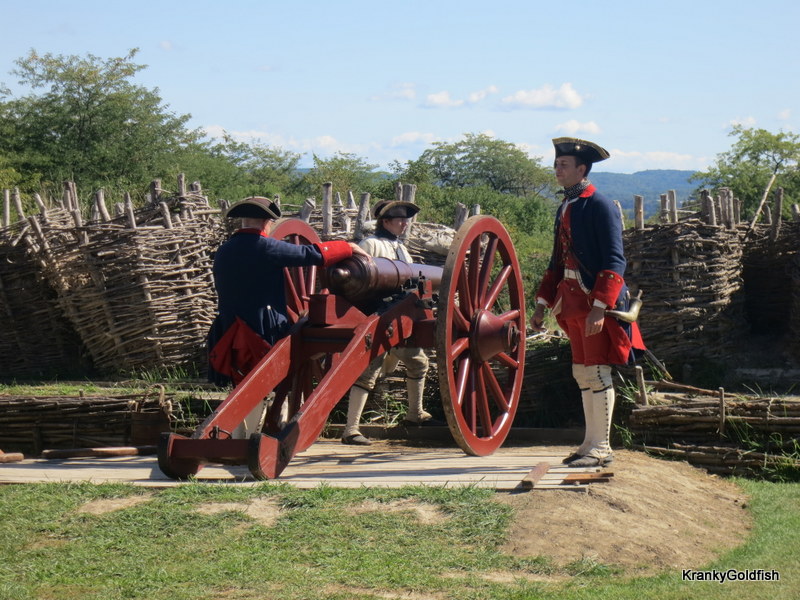
Loading one of the field pieces. Wicker baskets full of earth were used at the time to provide cover when stone fortifications were not available.

The cannon made a very satisfying boom!, and they loaded and fired it a second time, just so we would know it wasn’t a fluke.

We had a quick lunch at the cafe and went back to look at the fort some more. One of the good things about being in a market of 300 million people is that you get access to a wider range of snack flavours. These were very tasty (but could have used more horseradish).

In a farm beside the fort there were cattle grazing. Mr Cow gave it his best, but coudn’t quite fit in.
We really enjoyed Fort Ti. It might not be quite authentic, but there’s a lot of content and it’s very entertaining.
But we had to leave as we had a long drive to our next night’s stay. It was another good drive, on good roads through hills and mountains with plenty of landscape to see. But we had stayed a bit long at Fort Ti, so didn’t stop to take a lot of pictures.
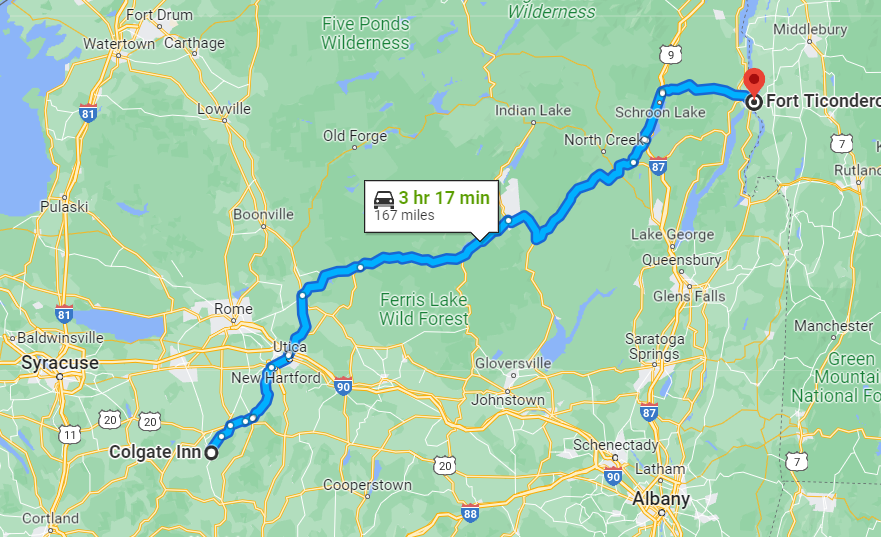
Hamilton is another small town in upstate New York, now also mostly known for the local university. We had booked in to the Colgate Inn to stay for the night, and it was lovely. We had considered staying in Utica or Rome, being bigger towns nearby, but Hamilton was just right for what we wanted.
Tourist tip – college towns make a great place to stay. Compared to non-college towns the same size, they tend to have good quality accommodation for parents and alumni to stay in when they visit, and a wider range of restaurants, because college kids love to eat and generally can’t cook for themselves when living in dorms. Just make sure you don’t try to stay there at Homecoming or in fresher’s week, everything will be booked solid.
Having said that, we were tired and it was kind of late so we just ate at the Inn’s restaurant, The Tavern.

The beer was nice, and those two piggies are having so much fun! And on the right is a pumpkin ale. In the lead-up to Halloween, Americans become obsessed with all things pumpkin. Pumpkin jack-o-lanterns, pumpkin pie, pumpkin spice lattes, and pumpkin beer. The beer is infused with the spices used in pumpkin pie – cinnamon, clove, allspice, nutmeg and more – and depending on the brewery, sometimes with pumpkin itself. Don’t worry, it gets strained out before bottling, the beer isn’t chunky.
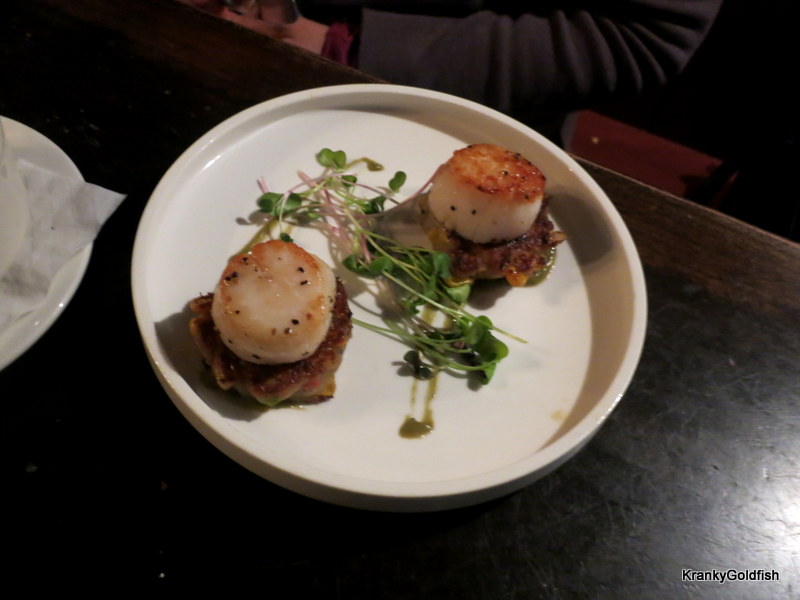
I mentioned Maine scallops before. Seared scallops on corn cakes with a herb puree were huge, meaty and delicious.

Southern fried chicken, I mean, we weren’t in the South but I couldn’t pass it up. And it was crispy, juicy and tasty, and so big! I think there was nearly half a chicken on that plate.
And so we wandered back up to bed, tired from a long day and full of good food.
Tomorrow is a really big day. We travel 128 miles to have garbage for breakfast, have a Kodak moment, and take a big fall.